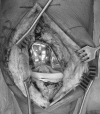Etiology and surgical interventions for stiff total knee replacements
- PMID: 18751792
- PMCID: PMC2504257
- DOI: 10.1007/s11420-007-9053-4
Etiology and surgical interventions for stiff total knee replacements
Abstract
Stiffness is the most prevalent early local complication of primary total knee replacement, affecting approximately 6 to 7% of patients undergoing surgery. The definition of stiffness after total knee replacement in terms of restriction of the arc of motion has evolved in the last 2 decades as patients and physicians expect better postoperative functional outcomes. Gentle manipulation under anesthesia within 3 to 4 months of surgery improves the range of motion in most patients. However, approximately 1% of patients, including those in which the window for manipulation has passed, will require further surgical interventions, which may include arthroscopy with lysis of adhesions, open debridement with exchange of the polyethylene insert, or revision of one or more components. This review will focus on describing the etiology of the problem and the results of the different surgical interventions for stiffness after total knee replacement.
Figures









Similar articles
-
Poor outcomes of isolated tibial insert exchange and arthrolysis for the management of stiffness following total knee arthroplasty.J Bone Joint Surg Am. 2001 Oct;83(10):1534-6. doi: 10.2106/00004623-200110000-00012. J Bone Joint Surg Am. 2001. PMID: 11679605
-
Outcome of Revision Surgery for the Idiopathic Stiff Total Knee Arthroplasty.J Arthroplasty. 2021 Mar;36(3):1067-1073. doi: 10.1016/j.arth.2020.09.005. Epub 2020 Sep 9. J Arthroplasty. 2021. PMID: 32988681
-
Protocol-Driven Revision for Stiffness After Total Knee Arthroplasty Improves Motion and Clinical Outcomes.J Arthroplasty. 2018 Sep;33(9):2952-2955. doi: 10.1016/j.arth.2018.05.013. Epub 2018 May 30. J Arthroplasty. 2018. PMID: 29859726
-
[Arthroscopic release for knee joint stiffness after total knee arthroplasty].Rev Chir Orthop Reparatrice Appar Mot. 2002 Apr;88(2):163-7. Rev Chir Orthop Reparatrice Appar Mot. 2002. PMID: 11973547 Review. French.
-
Stiffness after total knee arthroplasty.J Am Acad Orthop Surg. 2004 May-Jun;12(3):164-71. doi: 10.5435/00124635-200405000-00004. J Am Acad Orthop Surg. 2004. PMID: 15161169 Review.
Cited by
-
No clinical advantage with customized individually made implants over conventional off-the-shelf implants in total knee arthroplasty: a systematic review and meta-analysis.Arch Orthop Trauma Surg. 2024 Mar;144(3):1311-1330. doi: 10.1007/s00402-023-05090-8. Epub 2023 Nov 18. Arch Orthop Trauma Surg. 2024. PMID: 37979098
-
Early patellar tendon rupture after total knee arthroplasty: A direct repair method.World J Clin Cases. 2022 Nov 6;10(31):11349-11357. doi: 10.12998/wjcc.v10.i31.11349. World J Clin Cases. 2022. PMID: 36387798 Free PMC article.
-
Preoperative Valgus Alignment Does Not Predict Inferior Outcome of Total Knee Arthroplasty.HSS J. 2018 Feb;14(1):50-54. doi: 10.1007/s11420-017-9576-2. Epub 2017 Sep 12. HSS J. 2018. PMID: 29398995 Free PMC article.
-
Manipulation for stiffness following total knee arthroplasty: when and how often to do it?Eur J Orthop Surg Traumatol. 2014 Oct;24(7):1291-5. doi: 10.1007/s00590-013-1387-7. Epub 2013 Dec 11. Eur J Orthop Surg Traumatol. 2014. PMID: 24327007
-
How often is functional range of motion obtained by manipulation for stiff total knee arthroplasty?Int Orthop. 2014 Aug;38(8):1641-5. doi: 10.1007/s00264-014-2421-z. Epub 2014 Jul 4. Int Orthop. 2014. PMID: 24993649 Free PMC article.
References
-
- {'text': '', 'ref_index': 1, 'ids': [{'type': 'DOI', 'value': '10.1016/S0883-5403(89)80046-4', 'is_inner': False, 'url': 'https://doi.org/10.1016/s0883-5403(89)80046-4'}, {'type': 'PubMed', 'value': '2926403', 'is_inner': True, 'url': 'https://pubmed.ncbi.nlm.nih.gov/2926403/'}]}
- Aglietti P, Windsor RE, Buzzi R, Insall JN (1989) Arthroplasty for the stiff or ankylosed knee. J Arthroplasty 4:1–5 - PubMed
-
- {'text': '', 'ref_index': 1, 'ids': [{'type': 'PubMed', 'value': '11679605', 'is_inner': True, 'url': 'https://pubmed.ncbi.nlm.nih.gov/11679605/'}]}
- Babis GC, Trousdale RT, Pagnano MW, Morrey BF (2001) Poor outcomes of isolated tibial insert exchange and arthrolysis for the management of stiffness following total knee arthroplasty. J Bone Jt Surg Am 83-A:1534–1536 - PubMed
-
- {'text': '', 'ref_index': 1, 'ids': [{'type': 'PubMed', 'value': '8679025', 'is_inner': True, 'url': 'https://pubmed.ncbi.nlm.nih.gov/8679025/'}]}
- Bae DK, Lee HK, Cho JH (1995) Arthroscopy of symptomatic total knee replacements. Arthroscopy 11:664–671 - PubMed
-
- {'text': '', 'ref_index': 1, 'ids': [{'type': 'DOI', 'value': '10.1016/j.arth.2005.07.020', 'is_inner': False, 'url': 'https://doi.org/10.1016/j.arth.2005.07.020'}, {'type': 'PubMed', 'value': '16877149', 'is_inner': True, 'url': 'https://pubmed.ncbi.nlm.nih.gov/16877149/'}]}
- Bengs BC, Scott RD (2006) The effect of patellar thickness on intraoperative knee flexion and patellar tracking in total knee arthroplasty. J Arthroplasty 21:650–655 - PubMed
-
- {'text': '', 'ref_index': 1, 'ids': [{'type': 'PubMed', 'value': '3566893', 'is_inner': True, 'url': 'https://pubmed.ncbi.nlm.nih.gov/3566893/'}]}
- Campbell ED, Jr. (1987) Arthroscopy in total knee replacements. Arthroscopy 3:31–35 - PubMed
LinkOut - more resources
Full Text Sources
Medical

